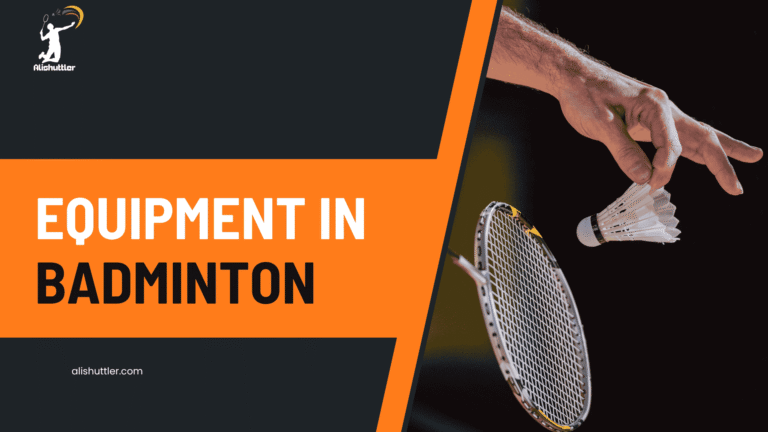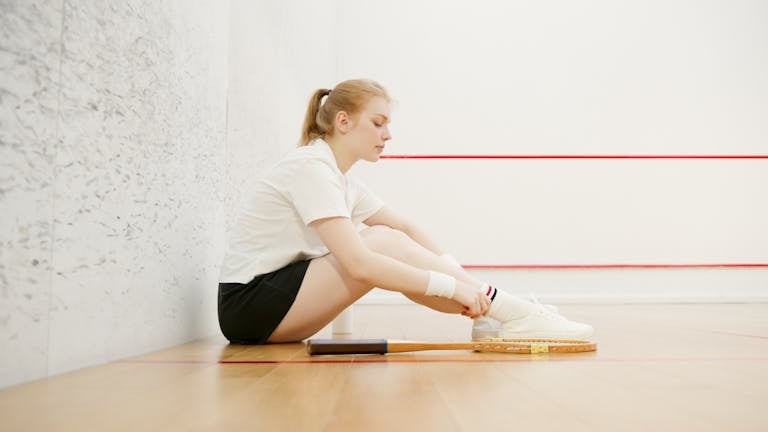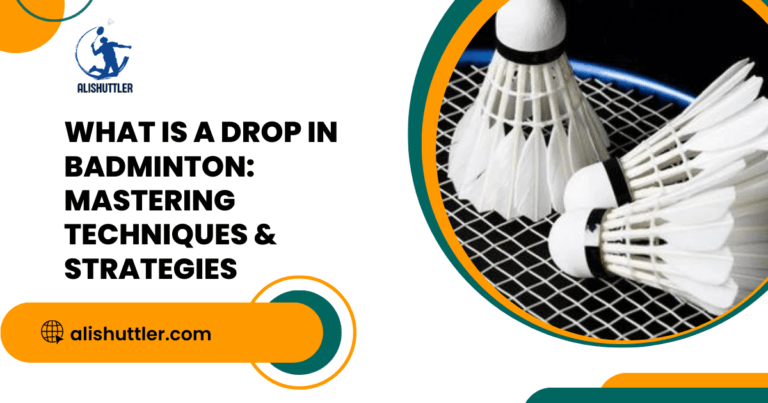Badminton racket length means the size from the tip of the head to the end of the handle, used to match the player’s reach and skill. Indeed, in the United States, most adult rackets are 26.5 inches long. This size is ideal for fitting into league rules while increasing balance and control.
Children’s rackets are much shorter, typically 21 to 23 inches, allowing younger players to hold and swing their rackets comfortably. Longer rackets will increase the power or velocity of your stroke. You’d be surprised how much difference a half-inch can make!
Understanding the correct racket length allows players to choose equipment that caters to their play style and gameplay. Learn how to find the right length for you next.
What is Badminton Racket Length?
Overall, the length of a badminton racket is an important specification. It dramatically impacts the game’s feel and a player’s performance. In the U.S., racket length is typically discussed in inches, while centimeters are used elsewhere.
The standard length of most rackets is 26.2 inches (66.5 cm). In practice, you can find models reaching as tall as 26.8 inches (68 cm), the official limit. These little changes may not sound like much, but they make a difference in comfort, reach,h and how fast play needs to move through a course.
Defining Racket Measurement
When measuring racket length simultaneously, begin at the tip of the frame. Next, bring the measurement down to the bottom of the handle. This applies to the entire racket, not just the head or the shaft.

Accurate measurement is key to ensuring fair play across all players and choosing the right racket for the right player’s physique or playing style. The most frequent error we see is measuring just the shaft. Don’t overlook the handle, or you might choose the wrong gear!
Measuring with a measuring tape, the entire length is the way to go. Whether you’re on the market for a new racket or just confirming an old one, this is the way to go!
Why Overall Length Matters
In addition, the length of a badminton racket will impact the distance a player can stretch and still hit the birdie. The shorter racket, like a 26.1-inch (66.5 cm) option, tends to provide a better connection for players with a shorter reach.
Plus, it allows you to put more power into your smashes! That added length can be a real asset in those last-second, panic saves. The downside is that shorter rackets are more manageable and swingable.
This benefit gives you more precision for net shots and fast exchanges. Each player will experience these differences in feeling when they move or swing. The final decision on overall length will be based on what feels comfortable and suits their game best.
Standard Racket Lengths Explained

Let us be clear – badminton rackets vary dramatically in length. Standard measurements provide a level playing field, particularly in the United States. Standard adult rackets usually are between 26.2 inches (665mm) and 26.8 inches (680mm).
Organizations such as the Badminton World Federation establish limits like these. They cap racket width at 9.1 inches (230mm). Since these dimensions significantly influence a racket’s overall feel and playability, understanding them can better guide players to the ideal racket for their game.
1. The Common Standard: 665mm
Rackets of this length, around 26.2 inches (665mm), are the typical standard for leisure and club play. This size is best for a wide range of players, particularly for beginners and teens.
Though technically a bit heavier, the shorter length certainly feels lighter and easier to swing, helping create better control for newer players. This balance of power and playability helps newcomers learn fundamental skills first.
It’s the ideal racket for youth and adults learning the game for the first time.
2. Extended Length: Up to 680mm
Some rackets extend beyond the traditional length to 26.8 inches (680mm). The additional length provides added reach and can sometimes provide extra power on smashes.
Most advanced players enjoy these rackets for heavy-hitting, dominating strokes. The difference between standard and extended lengths comes down to tradeoffs: a longer racket means more potradeoffsan be harder to control, while the shorter one favors quick handling.
3. Official Tournament Regulations
As you can see, the Badminton World Federation has stringent regulations regarding the length and width of rackets used in official tournaments. Players who do not use rackets within these specifications are subject to disqualification.
These regulations ensure standardized and equitable play throughout various competitions.
4. A Peek into the History
Racket lengths have steadily increased by inches over the years. Rackets were indeed shorter in the early days, when rackets were wood-framed.
As materials and play styles evolved, rackets became longer, allowing players to find a racket that best suited their unique play style.
How Length Impacts Your Game

The length of your modern badminton racket makes a real difference in your game, influencing everything from your reach to shot selection. The length you choose will significantly impact your shot-making power, control, and how you move on the badminton court. For U.S. players, most badminton rackets are 26 to 27 inches long, and those tiny changes can make a big difference.
Reach Advantage: Covering Court
By nature, longer rackets enhance your reach. That’s an additional 1.2% coverage you get for free! Whether you’re reaching for a shot on net or making a play in the far corner, this boost is handy.
On defense, this extra reach makes you more forgiving with saving smashes. Otherwise, those balls would be beyond your reach with a shorter racquet! On the attacking end, longer limbs help you pick off lanes early, removing your opponent’s angles.
In a tight doubles match, that additional inch might be the deciding factor in gaining or losing points.
Power Generation vs. Maneuverability
Lengthier rackets provide you with more power. A 19.4% increase in length can increase your avian velocity by as much as 8%. Lengthening the racket—particularly by inserting length at the head—also increases the racket’s swing weight.
While this head-heavy feel is beneficial for generating power, it drags down your hand speed. On rapid exchanges and volleys around the net, a shorter racket will be more easily maneuvered.
Usually, singles players looking for power tend to play longer, and doubles players who want more maneuverability might play a shorter frame.
Swing Speed and Aerodynamics
Increased length directly affects how fast you are able to swing. They’re able to move the shuttle at a greater speed, but only if you’re willing and able to bear the increased payload.
It’s the kinetic energy that’s important—not just the weight of the racket. If there is too much weight at the head it will delay your reaction, so finding that balance is important.
If you want to chase a fast drop, a shorter, lighter racket is more convenient to whip through the air.
Control and Shot Precision
The longer you go, the more difficult it is to land your ball in the exact same spot time after time. Having a butt cap that moves in your hand directly affects your accuracy.
For gamers who depend on accuracy—imagine drop shots or internet flicks—a much shorter racket provides optimum control. If you need a bit of both, consider a mid-length racket and focus on grip stability.
Biomechanics: Longer vs. Shorter
It’s no surprise that your body moves quite differently with each length. A longer racket affects the way you move your wrist and arm, which can put dangerous stress on your joints if you’re not doing it properly.
Excess length or an improper grip can even increase your risk of injury. Choosing the correct length tube for your height and riding style allows you to ride longer and safer.
Choosing the Right Racket Length
Choosing the correct length for your modern badminton racket requires more than just selecting what looks best off the shelf. It truly depends on your comfort level, play style, and how the racket aligns with your build. Some badminton rackets are slightly longer—up to 0.4 inches (10mm) over the standard. Each player, with each type, will not feel the same game. Here’s how to choose a racket length that’s right for you.
Your Height and Arm Span
Your height and arm span determine how a racket will feel in play. Taller players or those with longer arms may find that a longer racket helps with reach and power, while shorter players might value the control of a regular-length racket.
For instance, if you are more than 6′ tall, a longer racket might allow you to cover the court more effectively. That’s why testing both lengths is so important. Players often grip nearer the shaft to increase control, especially on block against fast drives.
Comfort should be your top priority; a racket that sits well in your grip will ensure the most effortless game flow.
Skill Level: Beginner to Pro
You’ll want to remember new players typically learn on standard-length rackets, since they are more manageable. As players progress, many graduate to longer rackets for added reach or power—particularly when developing smashes.
Even professional players change their racket length as their personal technique develops. Increase the length as your confidence and control develop.
Playing Style: Offensive or Defensive?
Playing style: Offensive or defensive? Offensive players will want longer rackets for more powerful smashes and sharper angles. Defensive players will usually want standard lengths for fast reactions.
On one hand, the greatest players in the world are choosing to lengthen their rackets for added power.
Injury Prevention Insights
Proper length usage prevents unnecessary shoulder or wrist strain. If the racket is too long or too short, it will encourage cumbersome swings.
Choose whatever feels most comfortable and allows you to maintain a stable grip and swing.
Pro Choices vs. Amateur Needs
Pros optimize the modern badminton racket length for each side, while amateurs should focus on badminton rackets that provide comfort and control to enhance their skill level.
Racket Length for Kids: A Guide
Picking the appropriate length for a badminton racket sets a youth’s initial impression with the sport. Getting the right fit ensures that kids are developing skills, having fun, and playing as safely as possible. When choosing a racket for a kids player, in most cases, height should be your primary concern.
Age and skill level are important, but don’t let those be the only factors! A racket that is appropriate for their size allows them to swing comfortably and develop the right skills early on. Our guide explains how size does matter, and which ones are most effective for each age.
Why Shorter Rackets for Juniors
Like full-size rackets, shorter rackets will allow more control for young players. By having a shorter length, the racket will be lighter and easier to balance in tiny hands. This allows children to better control the racket, hit the ball cleanly, and develop their targeting and aiming over time.
An average five or six-year-old, roughly 41 inches tall, is able to effectively swing a 16-inch racket. They do all this with very remarkable control! If a racket is too long, they will find it difficult to hit the shuttle or keep the racket on target. A shorter racket ensures they can handle the basics and allows them to concentrate on their swing.
Badminton Racket Size Chart by Age
Here’s a quick chart for picking racket length by height:
- 41–44 cm (16–17 in): for kids 41–47 in tall
- 52–55 cm (20–22 in): for kids 43–49 in tall
- 57–60 cm (22–24 in): for kids 47–53 in tall
- 60–62 cm (24–24.5 in): for kids 51–55 in tall
Children who are more than 10 years of age would usually be comfortable with a 26 inch racket that is the norm. Regardless of size, do make sure that your child is able to swing the racket comfortably. Some will be able to handle a full-size option earlier than others.
Nurturing Proper Kid’s Technique
The correct length allows children to employ the proper grip and swing path. Parents have an important role in this, too—specifically when it comes to racket selection. As a general rule, lighter rackets (about 3 ounces) are the way to go for beginners.
Once kids begin to understand the sport, they begin creating good habits. This mitigates them developing poor form that might stick with them as they mature.
Making Badminton Fun for Kids
A modern badminton racket that fits you well will result in less missed shots and longer rallies. Kids are interested, they’re having a great time, and they want to play more. Fun games, lightweight badminton rackets, and the opportunity to play with the best sports equipment right away all get kids to fall in love with badminton early on.
My Unique Take on Racket Length
There’s more to the overall length of a modern badminton racket than meets the eye. The real world limit is around 26.77 inches. What feels good in your hand, including the grip size and material, is equally important as the spec sheet. My opinions on racket length are the result of extensive testing, not simply reading the user guide.
Feel Over Specs: A Personal View
For me, it’s all about how a racket feels, not what the specs say. I’ve played on models that hit the maximum length and others that were truncated slightly. The weight drop was minimal.
On one occasion, I was sawing off the end of a broken handle, and the majority of what was coming off was hollow. The alteration in equity was genuine! Many players choke up on the grip.
So cutting some of the handle off may be the most logical thing in the world… if it feels good! Feel over specs. What suits one person may be the best for that individual but not work for anyone else.
Experimentation: Your Best Bet
With all these variables at play, it’s impossible to predict the perfect racket length for you. If possible, try out the rackets before you buy them and hit a few balls with them.
Pay attention to how fast your hand seems and how firm the head is on the ball! Players will chop off some of the handle length to test and find out if it drastically increases the maneuverability of the racket.
Experimentation, as it turns out, is your best bet.
Length’s Role in Advanced Shots
Length’s ability to affect the execution of advanced shots is significant. What extra reach really excels at is making a racer’s smashes and net kills more effective.
While shorter rackets do provide an advantage in quick, tricky adjustments at the net, the trade-off could be a lack of power.
Fututradeoff Trends: My Thoughts
I know brands are testing lighter, more balanced designs that flirt with the edge of the length rules without crossing them.
Look for greater customization possibilities in fit and balance.
Length, Strings, and Balance Synergy
Length, strings, and balance all work together in modern badminton racket performance. Look for a combination that suits your swing, not what’s popular right now.
Conclusion
With these fundamentals in mind, finding your ideal badminton racket length will seem like a breeze. Shorter rackets provide children with more control. Adult players enjoy added reach with longer rackets. In general stores, most rackets are around 26-27 inches, ideal for the average people. Finding the right size is the key to better hits. It further lets you play fluidly, whether you play competitively in your backyard or at a local YMCA.

Not a reason to follow every trend or get all the expensive equipment, just choose what works for your grip and feels good when you’re moving. Ready to perform at your peak level? So next time you’re out shopping, notice the length before you purchase. Play around with various rackets, swing a few, see what feels right. A little help from quality gear could go a long way toward rediscovering a lost passion for the game.
Frequently Asked Questions
What is the standard length of a badminton racket in the U.S.?
Almost all adult badminton rackets sold in the U.S. measure 26.5 inches (67.3 cm) in overall length, making them suitable for various skill levels in recreational and competitive play.
Does racket length affect my performance?
Does the length of modern badminton rackets really impact performance? A longer racket design offers increased reach, while a shorter badminton racquet provides better control and faster swing speed.
Can kids use adult-sized badminton rackets?
For young athletes, using shorter badminton rackets, typically 21–23 inches in length, provides better control and helps them develop their technique effectively.
How do I choose the right racket length?
Choose the ideal length of your modern badminton racket according to your height, advanced skill level, and playing style. Longer badminton rackets provide more reach, making them preferable for taller or more aggressive players.
Are there different lengths for doubles and singles play?
Are there different lengths for doubles and singles play? It’s possible that your skill level and style of play would determine the modern badminton racket length you like best.
Do professional players use standard-length rackets?
Even though the majority of pros are using modern badminton rackets right around the 26.5-inch length, they might make a small exception for the sake of personal preference.
Is a longer racket always better for beginners?
For beginners, especially young athletes, shorter badminton rackets are much more controllable and maneuverable, which can help them learn the basics much more easily.






